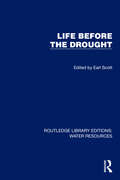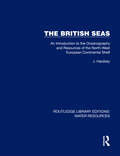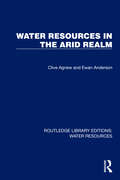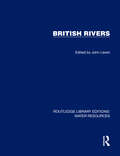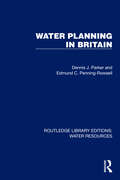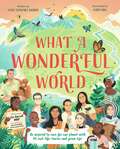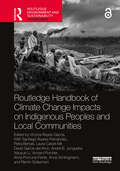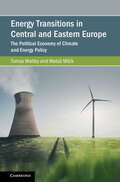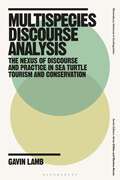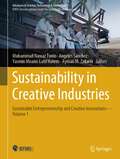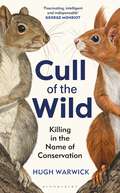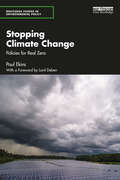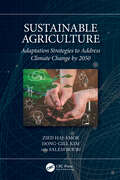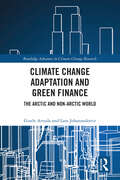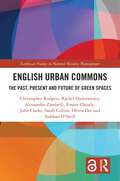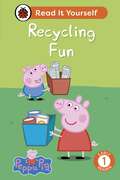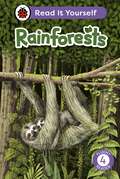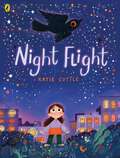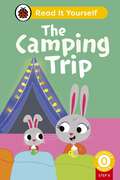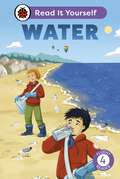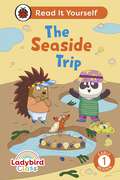- Table View
- List View
Life Before the Drought (Routledge Library Editions: Water Resources)
Little attention had been paid to the realities of life in the Savanna-Sahel of West Africa before the drought of 1968-74, but this book, originally published in 1984 provides a set of authoritative accounts of the way in which the inhabitants cope with what outsiders perceive as a harsh environment. The peoples of the Savanna-Sahel are shown to be developers of strategies and technologies to manage their resources. Their understanding of the environment enables them to contribute substantially to any plans for economic and ecological recovery in the region. Their cooperative modes of life lead to greater social complexity and capacity for survival. Geographers, anthropologists and social historians should find the interdisciplinary human ecological approach of the book appealing. Development economists and rural planners will find the chapters on land-use patterns, and resource use particularly valuable.
The British Seas: An Introduction to the Oceanography and Resources of the North-West European Continental Shelf (Routledge Library Editions: Water Resources)
by Jack HardistyOriginally published in 1990 and designed as a student text, The British Seas is a clear introduction to the oceanography and resources of the region. It is unique in providing a detailed review of the resources of the north-west European continental shelf together with a comprehensive description of the environment. Introducing the shelf region as if it were a new country, Jack Hardisty explores first its physical environment and then summarizes the distribution and exploitation of resources from the environment. Part 1 – on the oceanography - covers the shape of the shelf, its geological history and its wave and tidal regimes. Part 2 – on the resources – looks at trade and shipping, and the hydrocarbon, fishing and seabed mining industries. It goes on to discuss wave and tidal power, and to consider the problem of pollution in terms of resource utilization. The industrial technology and the environmental potential of each resource are examined, and the economic and legislative restrictions are analysed.
Water Resources in the Arid Realm (Routledge Library Editions: Water Resources)
by Clive Agnew Ewan AndersonOriginally published in 1992, this book dispels some of the myths that surround water resource problems of arid lands and the notion that there are simple ‘once and for all’ solutions. Population growth, industrialization, environmental mismanagement and land degradation have led to droughts, poverty and famine with the result that the need for space, food and key natural resources such as water has become the most critical issue in global development. Nowhere is this crisis more apparent than in arid lands, where water resources provide the key to economic and environmental development. The authors argue that as the arid land environment is highly variable the key to success is flexibility. The book is divided into four sections, dealing with the geography of the arid realm; the water resource problems they face: the methods available for enhancing water supplies and finally, management of this resource. The book will be of use to undergraduate and postgraduate student and for those actively engaged in the development of arid land water resources.
British Rivers (Routledge Library Editions: Water Resources)
Originally published in 1981, this book describes and interprets the physical nature of British rivers and is authored by leading authors from universities, the Institute of Hydrology and a water Authority. The contents include data on river regimes and catchment characteristics, information on water quality in both polluted and unpolluted rivers, a full discussion of river channels and their erosion and sediment characteristics, and a consideration of river management problems in the distinctive British context. Where possible, nationwide information is presented in map form and many of the maps presented a national picture for the first time. The book will be of interest to students and scientists in a wide range of disciplines: geography, geology, environmental science, hydrology and engineering. Those professionally engaged in environmental management and the water industry should also find it useful. In summary, all who are concerned with rivers – as agents of landscape change, sedimenting phenomena, environmental resources or flood hazards will find this book as relevant now as when it was first published.
Water Planning in Britain (Routledge Library Editions: Water Resources)
by Dennis J. Parker Edmund C. Penning-RowsellOriginally published in 1980, this book provides a penetrating and scholarly analysis of the planning of water resources, based on 10 years’ of research into one of Britain’s most vital industries. At the time of original publication Britain had a plentiful natural supply of water, but accessible clean water was scarce; droughts were not uncommon, floods often caused considerable damage; water bills were rising dramatically and consumption increasing inexorably. All of which applies as much to water resources in the UK today. Water planners must strike a delicate balance between many conflicting social, environmental, political and financial demands. Britain’s water authorities are large and autonomous organisations subject to constant change and controversy. Water policies affect not only water but also land-use planning, recreation planning, environmental quality, food production and the maintenance of public health. The book explains common threads and issues in the planning of 4 main water functions: water supply, effluent disposal and pollution control, water recreation and amenity and land drainage and flood alleviation. 11 original British case studies have been selected to illustrate the issues involved. The final chapter presents a critical and controversial evaluation of water policy and planning institutions in Britain, highlighted by some international comparisons.
Water Planning in Britain (Routledge Library Editions: Water Resources)
by Dennis J. Parker Edmund C. Penning-RowsellOriginally published in 1980, this book provides a penetrating and scholarly analysis of the planning of water resources, based on 10 years’ of research into one of Britain’s most vital industries. At the time of original publication Britain had a plentiful natural supply of water, but accessible clean water was scarce; droughts were not uncommon, floods often caused considerable damage; water bills were rising dramatically and consumption increasing inexorably. All of which applies as much to water resources in the UK today. Water planners must strike a delicate balance between many conflicting social, environmental, political and financial demands. Britain’s water authorities are large and autonomous organisations subject to constant change and controversy. Water policies affect not only water but also land-use planning, recreation planning, environmental quality, food production and the maintenance of public health. The book explains common threads and issues in the planning of 4 main water functions: water supply, effluent disposal and pollution control, water recreation and amenity and land drainage and flood alleviation. 11 original British case studies have been selected to illustrate the issues involved. The final chapter presents a critical and controversial evaluation of water policy and planning institutions in Britain, highlighted by some international comparisons.
British Rivers (Routledge Library Editions: Water Resources)
by John LewinOriginally published in 1981, this book describes and interprets the physical nature of British rivers and is authored by leading authors from universities, the Institute of Hydrology and a water Authority. The contents include data on river regimes and catchment characteristics, information on water quality in both polluted and unpolluted rivers, a full discussion of river channels and their erosion and sediment characteristics, and a consideration of river management problems in the distinctive British context. Where possible, nationwide information is presented in map form and many of the maps presented a national picture for the first time. The book will be of interest to students and scientists in a wide range of disciplines: geography, geology, environmental science, hydrology and engineering. Those professionally engaged in environmental management and the water industry should also find it useful. In summary, all who are concerned with rivers – as agents of landscape change, sedimenting phenomena, environmental resources or flood hazards will find this book as relevant now as when it was first published.
Water Resources in the Arid Realm (Routledge Library Editions: Water Resources)
by Clive Agnew Ewan AndersonOriginally published in 1992, this book dispels some of the myths that surround water resource problems of arid lands and the notion that there are simple ‘once and for all’ solutions. Population growth, industrialization, environmental mismanagement and land degradation have led to droughts, poverty and famine with the result that the need for space, food and key natural resources such as water has become the most critical issue in global development. Nowhere is this crisis more apparent than in arid lands, where water resources provide the key to economic and environmental development. The authors argue that as the arid land environment is highly variable the key to success is flexibility. The book is divided into four sections, dealing with the geography of the arid realm; the water resource problems they face: the methods available for enhancing water supplies and finally, management of this resource. The book will be of use to undergraduate and postgraduate student and for those actively engaged in the development of arid land water resources.
What a Wonderful World: Be inspired to care for our planet with 35 real-life stories and green tips
by Leisa Stewart-SharpeOur world is WONDERFUL - and it's worth protecting. From the author of the BBC's children's book Blue Planet II, this book takes you on a breathtaking tour of our planet - from towering mountaintops, through grasslands, jungles, rivers, deserts, polar wildernesses and into the blue ocean - to discover the incredible variety of life that calls it home. Along the way, read the stories of 35 inspiring Earth Shakers - children and adults, from tree-planters to scientists, from all around the world - who have taken action to protect it. Plus, there are lots of practical tips and handy resources inside that give you the tools to make a positive change today. Every budding young activist will be inspired to make a change for a better future. Includes a special foreword from Lee Durrell MBE, of Durrell Wildlife Conservation Trust.
Routledge Handbook of Climate Change Impacts on Indigenous Peoples and Local Communities (Routledge Environment and Sustainability Handbooks)
by Victoria Reyes-GarcíaThis Handbook examines the diverse ways in which climate change impacts Indigenous Peoples and local communities and considers their response to these changes.While there is well-established evidence that the climate of the Earth is changing, the scarcity of instrumental data oftentimes challenges scientists’ ability to detect such impacts in remote and marginalized areas of the world or in areas with scarce data. Bridging this gap, this Handbook draws on field research among Indigenous Peoples and local communities distributed across different climatic zones and relying on different livelihood activities, to analyse their reports of and responses to climate change impacts. It includes contributions from a range of authors from different nationalities, disciplinary backgrounds, and positionalities, thus reflecting the diversity of approaches in the field. The Handbook is organised in two parts: Part I examines the diverse ways in which climate change – alone or in interaction with other drivers of environmental change – affects Indigenous Peoples and local communities; Part II examines how Indigenous Peoples and local communities are locally adapting their responses to these impacts. Overall, this book highlights Indigenous and local knowledge systems as an untapped resource which will be vital in deepening our understanding of the effects of climate change.The Routledge Handbook of Climate Change Impacts on Indigenous Peoples and Local Communities will be an essential reference text for students and scholars of climate change, anthropology, environmental studies, ethnobiology, and Indigenous studies.The Open Access version of this book, available at www.taylorfrancis.com, has been made available under a Creative Commons Attribution-Non Commercial-No Derivatives (CC-BY-NC-ND) 4.0 license.
Energy Transitions in Central and Eastern Europe: The Political Economy of Climate and Energy Policy (Cambridge Studies on Environment, Energy and Natural Resources Governance)
by null Tomas Maltby null Matúš MišíkThis book examines the mutual interplay of climate and energy policies in eleven Central and Eastern European countries in the context of the EU's energy transition. Energy security has long been prioritised in the region and has shaped not only national climate and energy policy, but also EU-level policy-making and implementation. Whilst the region shares economic, institutional and historical energy supplier commonalities it is not homogenous, and the book considers the significant differences between the preferences and policies of these member states. Chapters also explore the effect of the EU on member states that have joined since 2004 and their influence on the EU's energy and climate policies and their role in highlighting the importance of the concepts of security and solidarity. The book highlights the challenges to, and drivers of, energy transitions in the region and compares these with those in global energy transitions.
Multispecies Discourse Analysis: The Nexus of Discourse and Practice in Sea Turtle Tourism and Conservation (Bloomsbury Advances in Ecolinguistics)
by Dr Gavin LambThis book explores how language and communication shape the increasingly entangled lives of people and sea turtles at the nexus of sea turtle conservation and ecotourism. Here, new ecocultural identities are taking shape as people strive to make sense of their shifting multispecies landscape, and as sea turtles gradually reclaim beaches after decades of absence. The book offers researchers in ecolinguistics and related ecologically engaged fields in discourse analysis an integrative theoretical and methodological approach to empirically investigate the human and 'more-than-human' discourses and practices shaping problematic human-wildlife interaction. Containing short vignettes in each chapter covering the biology and behaviours of sea turtles, this book suggests how discourse analysts might contribute to a 'life-sustaining multispecies ethics' in an uncertain socio-ecological time increasingly being referred to as the Anthropocene.
Multispecies Discourse Analysis: The Nexus of Discourse and Practice in Sea Turtle Tourism and Conservation (Bloomsbury Advances in Ecolinguistics)
by Dr Gavin LambThis book explores how language and communication shape the increasingly entangled lives of people and sea turtles at the nexus of sea turtle conservation and ecotourism. Here, new ecocultural identities are taking shape as people strive to make sense of their shifting multispecies landscape, and as sea turtles gradually reclaim beaches after decades of absence. The book offers researchers in ecolinguistics and related ecologically engaged fields in discourse analysis an integrative theoretical and methodological approach to empirically investigate the human and 'more-than-human' discourses and practices shaping problematic human-wildlife interaction. Containing short vignettes in each chapter covering the biology and behaviours of sea turtles, this book suggests how discourse analysts might contribute to a 'life-sustaining multispecies ethics' in an uncertain socio-ecological time increasingly being referred to as the Anthropocene.
Sustainability in Creative Industries: Sustainable Entrepreneurship and Creative Innovations—Volume 1 (Advances in Science, Technology & Innovation)
by Muhammad Nawaz Tunio Angeles Sánchez Yasmin Moanis Latif Hatem Ayman M. ZakariaThis book discusses a compelling array of topics at the intersection of entrepreneurship, education, and technological innovation within the creative industries. It delves into a captivating exploration of sustainable entrepreneurship in Part 1, where key characteristics of sustainable entrepreneurs and factors influencing entrepreneurial intention are dissected. By unearthing the nexus between entrepreneurial alertness, networking capability, and venture performance, it provides intriguing insights into sustaining traditional crafts and brands amid the COVID-19 pandemic. The following parts not only unveil current innovative pedagogical strategies in creative design education but propels you into the future, exploring the harmonious fusion of academia and industry in sustainability-driven programs. Designed for educators, students, researchers, and practitioners in entrepreneurship, design, and technology fields, this book offers a transformative journey into sustainable practices, innovative pedagogies, and cutting-edge advancements. Engaging, informative, and thought-provoking, it is a must-read for those seeking to shape the future of creative industries through entrepreneurship, education, and innovation.
Cull of the Wild: Killing in the Name of Conservation
by Hugh WarwickInvestigating the ethical and practical challenges of one of the greatest threats to biodiversity: invasive species.Across the world, invasive species pose a danger to ecosystems. The UN Convention on Biological Diversity ranks them as a major threat to biodiversity on par with habitat loss, climate change and pollution.Tackling this isn't easy, and no one knows this better than Hugh Warwick, a conservationist who loathes the idea of killing, harming or even eating animals. Yet as an ecologist, he is acutely aware of the need, at times, to kill invasive species whose presence harms the wider environment.Hugh explores the complex history of species control, revealing the global movement of species and the impacts of their presence. Combining scientific theory with gentle humour in his signature style, he explains the issues conservationists face to control non-native animals and protect native species – including grey and red squirrels on Anglesey, ravens and tortoises in the Mojave Desert, cane toads in Australia and the smooth-billed ani on the Galapagos – and describes cases like Pablo Escobar's cocaine hippos and the Burmese python pet trade.Taking a balanced and open approach to this emotive subject, Hugh speaks to experts on all sides of the debate. How do we protect endangered native species? Which species do we prioritise? And how do we reckon with the ethics of killing anything in the name of conservation?
Stopping Climate Change: Policies for Real Zero (Routledge Studies in Environmental Policy)
by Paul EkinsWritten by one of the leading experts in the field, Paul Ekins, Stopping Climate Change provides a comprehensive overview of what is required to achieve ‘real zero’ carbon dioxide emissions by 2050, and negative emissions thereafter, which is the only way to stop human- induced climate change.This will require innovation in socio-technical systems, and in human behaviour, on an unprecedented scale. Stopping Climate Change describes the changes required to meet this goal: in technologies, social institutions and individual activities. Paul Ekins examines in detail issues around the supply and demand of energy and materials, and the efficiency of their use. It also analyses greenhouse gas removal technologies, offsetting and geoengineering, and plots the reduction of the non- CO2 greenhouse gas-emitting activities. Having set out the changes required, Ekins considers the economic implications, in terms of both the innovation and investments that are necessary to bring them about, and the effects that these are likely to have on national economies. The evidence presented points clearly to the economic impacts of decarbonisation being positive for the majority of countries, and for the world as a whole, even before considering the benefits of avoided climate change. When the health benefits of stopping the burning of fossil fuels are factored in, the global net benefits of decarbonisation are unequivocal.Drawing on examples from the UK and Europe, but with wider relevance at a global scale, Stopping Climate Change clearly shows how determined policy action at different levels could stop climate change. It will be of great interest to students, scholars and policymakers researching and working in the field of climate change and energy policy.
Sustainable Agriculture: Adaptation Strategies to Address Climate Change by 2050
by Zied Haj-Amor Dong-Gill Kim Salem BouriEver-increasing population growth, combined with ongoing climate change signals that agriculture will face great challenges in ensuring global food security by 2050. Additionally, climate change-driven variations in mean sea level, wave conditions, storm surge, droughts, and river flows could have serious effects on agriculture and other sectors. Considering these factors and the extremely high value and necessity of agriculture worldwide, effective adaptation measures underpinned by reliable climate change impact assessments are essential to conserve soil and water resources and ensure food security. Sustainable Agriculture: Adaptation Strategies to Address Climate Change by 2050 provides a thorough examination of these issues, and presents in-depth analysis, practical case studies, and numerous examples of adaptation options throughout for various regions of the world.Features: Presents up-to-date, scientifically robust information on climate change projections in Europe, Asia, America, Africa, and Australia Provides pathways to sustainable agricultural options rather than just defining the climate change issue Includes case studies and practical examples throughout the world Presents a framework by which policymakers can begin implementing strategies for improving agricultural productivity
Climate Change Adaptation and Green Finance: The Arctic and Non-Arctic World (Routledge Advances in Climate Change Research)
by Gisele Arruda Lara JohannsdottirThis book presents specific case studies of climate finance in the Arctic and examines how the green revolution could be a game changer in this sensitive region.Bringing together contributions from a range of experts in the field, Climate Change Adaptation and Green Finance assesses the costs of inaction versus the costs of action based on case study examples of climate finance and sustainable investment in the Arctic region. The authors draw on data from the Sixth Assessment Report published by the Intergovernmental Panel on Climate Change and respond with a solutions-based framework. This is developed around the notion of a new, carbon-neutral economy in the Arctic and presents methods for unlocking carbon finance and long-term climate investment in the region, such as finance for Arctic entrepreneurs and resilient sustainable investment structures. This volume also looks at the role of finance in meeting the United Nations Sustainable Development Goals and the ways in which innovation in investment will help shape the future of the Arctic. Climate Change Adaptation and Green Finance will be of great interest to students and scholars of climate change, sustainable finance, and sustainable business.
English Urban Commons: The Past, Present and Future of Green Spaces (ISSN)
by Christopher Rodgers Rachel Hammersley Alessandro Zambelli Emma Cheatle John Wedgwood Clarke Sarah Collins Olivia Dee Siobhan O’NeillThis book presents a novel examination of urban commons which provides a robust base for education initiatives and future public policy guidance on the protection and use of urban commons as invaluable urban green spaces that offer a diverse cultural and ecological resource for future communities.This book's central argument is that only through a deep understanding of the past and a rigorous engagement with present users can we devise new futures or imaginaries of culture, well-being and diversity for the urban commons. It argues that understanding the genesis of, and interactions between, the different pressures on urban green space has important policy implications for the delivery of nature conservation, recreational access and other land use priorities. The stakeholders in today’s urban commons, whether land users, policy makers or the public, are the inheritors of a complex cultural legacy and must negotiate diverse and sometimes conflicting objectives in their pursuit of a potentially unifying goal: a secure future for our urban commons. This book offers a unique and strongly interdisciplinary study of urban commons, one that brings together original historical investigation, contemporary legal scholarship, extensive oral history research with user groups and research examining the imagined futures for the urban common in modern society. It explores the complex social and political history of the urban common, as well as its legal and cultural status today, using four diverse case studies from within England as exemplars of the distinctively urban common. These are Town Moor in Newcastle, Mousehold Heath in Norwich, Clifton and Durdham Downs in Bristol and Valley Gardens in Brighton. This book concludes by looking forward and considering new tools and methods of negotiation, inclusivity and creativity to inform the future of these case studies, and of urban commons more widely.This book will be of great interest to students and scholars of the commons, green spaces, urban planning, environmental and urban geography, environmental studies and natural resource management.The Open Access version of this book, available at www.taylorfrancis.com, has been made available under a Creative Commons [Attribution-Non Commercial-No Derivatives (CC-BY-NC-ND)] 4.0 license.
Peppa Pig Recycling Fun: Read It Yourself - Level 1 Early Reader (Read It Yourself)
by Ladybird Peppa PigBased on the award-winning children's series!Featuring everyone's favourite little piggy, Peppa! Join Peppa and her family on their fun day recycling their rubbish. You'll never guess what Miss Rabbit tries to recycle next...Peppa Pig: Recycling Fun is is from Early Reader Level 1 and is perfect for children aged from 4+ who are taking their first steps beyond phonics.Each book has been carefully checked by educational and subject consultants and includes comprehension puzzles, book band information, and tips for helping children with their reading.With five levels to take children from first phonics to fluent reading and a wide range of different stories and topics for every interest, Read It Yourself helps children build their confidence and begin reading for pleasure
Rainforests: Read It Yourself - Level 4 Fluent Reader (Read It Yourself)
by LadybirdHalf of all the animal and plant species on Earth live in rainforests. Discover forest life, from the monkeys which jump around the sunny tree-tops, to the snakes that slither along the dark and damp forest floor.Rainforests is from Fluent Reader Level 4 and is ideal for more fluent readers aged from 7+ who are starting to read independently.Each book has been carefully checked by educational and subject consultants and includes comprehension puzzles, book band information, and tips for helping children with their reading.With five levels to take children from first phonics to fluent reading and a wide range of different stories and topics for every interest, Read It Yourself helps children build their confidence and begin reading for pleasure.
Night Flight
by Katie CottleFrom author-illustrator Katie Cottle comes a breath-taking journey about light pollution and saving the birdsWhen Ellie moves from her quiet village to a bustling city, she finds that the many different birds she loves to watch are missing. She stares out of her window, searches the skies on walks, but they are nowhere to be found. Then one night, she's visited by a giant starling which asks for her help. The birds are lost because of the shimmering glow from the city's bright lights.Can Ellie help the birds find their way home?Night Flight is a hopeful, inspiring story about the power of using your voice.
The Camping Trip (Read It Yourself)
by LadybirdTwo stories that build on the phonics learned in previous steps and focus on the sound and letter combinations: igh, ear, air, ure.The Camping Trip is from Beginner Reader Level 0 and is ideal for children aged from 4+ who are developing their phonics and early reading skills.Each book has been carefully checked by educational and subject consultants and includes comprehension puzzles, book band information, and tips for helping children with their reading.With five levels to take children from first phonics to fluent reading and a wide range of different stories and topics for every interest, Read It Yourself helps children build their confidence and begin reading for pleasure.
Water: Read It Yourself - Level 4 Fluent Reader (Read It Yourself)
by LadybirdHumans, animals, and plants need water every day to survive. But where does it come from? How do we know if it is safe to drink? Learn all about how water is saved, cleaned, and shared in this fact-filled book. Water is from Fluent Reader Level 4 and is ideal for more fluent readers aged from 7+ who are starting to read independently.Each book has been carefully checked by educational and subject consultants and includes comprehension puzzles, book band information, and tips for helping children with their reading. With five levels to take children from first phonics to fluent reading and a wide range of different stories and topics for every interest, Read It Yourself helps children build their confidence and begin reading for pleasure.
Ladybird Class The Seaside Trip: Read It Yourself - Level 1 Early Reader (Read It Yourself)
by LadybirdJoin Ladybird Class on another imaginative learning adventure! The class find themselves on a beach and meet Clippy Crab in his rock pool home. When the class learn about all the rubbish on the beach, how can they help the seaside creatures?The Seaside Trip is from Early Reader Level 1 and is perfect for children aged from 4+ who are taking their first steps beyond phonics.Each book has been carefully checked by educational and subject consultants and includes comprehension puzzles, book band information, and tips for helping children with their reading.With five levels to take children from first phonics to fluent reading and a wide range of different stories and topics for every interest, Read It Yourself helps children build their confidence and begin reading for pleasure.
